Kano State
Kano State (Hausa: Jihar Kano جِهَرْ كَنُوَ; Fula: 𞤤𞤫𞤴𞤣𞤭 𞤳𞤢𞤲𞤮𞥅, romanized: Leydi Kano) is one of the 36 states of Nigeria, located in the northern region of the country.[6] According to the national census done in 2006, Kano State is the most populous state in Nigeria. The recent official estimates taken in 2016 by the National Bureau of Statistics found that Kano State was still the largest state by population in Nigeria.[7][8] Created in 1967 out of the former Northern Region, Kano State borders with Katsina State to the northwest, Jigawa State to the northeast, Bauchi State to the southeast for 131 km (82 miles), and Kaduna State to the southwest for 255 km.[6] The state's capital and largest city is the city of Kano, the second most populous city in Nigeria after Lagos.[6] The incumbent governor of the state is Abba Kabir Yusuf. He was sworn in on 29 May 2023.[9]
Kano State
Jihar Kano جِهَرْ كَنُوْ (Hausa) | |
|---|---|
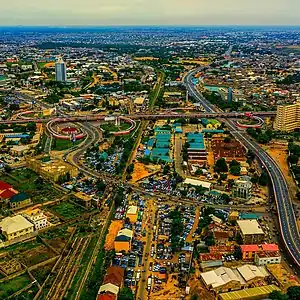 | |
 Flag 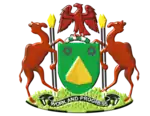 Seal | |
| Nicknames: Centre of Commerce, Tumbin Giwa | |
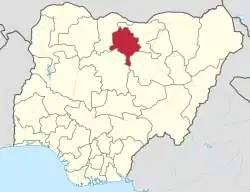 Location of Kano State in Nigeria | |
| Coordinates: 11°30′N 8°30′E | |
| Country | |
| Date created | 27 May 1967 |
| Capital | Kano |
| Government | |
| • Body | Government of Kano State |
| • Governor[1] | Abba Kabir Yusuf (NNPP) |
| • Deputy Governor | Aminu Abdussalam Gwarzo (NNPP) |
| • Legislature | Kano State House of Assembly |
| • Senators | C: Rufai Hanga (NNPP) N: Barau Jibrin (APC) S: Kawu Sumaila (NNPP) |
| • Representatives | List |
| Area | |
| • Total | 20,131 km2 (7,773 sq mi) |
| • Rank | 20th of 36 |
| Population (2023 census)[2] | |
| • Total | 21,389,766 |
| • Estimate (2020) | 20,000,000[3] |
| • Rank | 1st of 36 |
| • Density | 1,100/km2 (2,800/sq mi) |
| GDP (PPP) | |
| • Year | 2021 |
| • Total | $27.17 billion[4] 13th of 36 |
| • Per capita | $1,761[4] 36th of 36 |
| Time zone | UTC+01 (WAT) |
| postal code | 700001 |
| ISO 3166 code | NG-KN |
| HDI (2021) | 0.481[5] low · 29th of 37 |
| Website | www |
| ^1 Preliminary results | |
Modern day Kano State was the site of a number of prior kingdoms and empires, including the Kingdom of Kano, which was centered in Dalla Hill and existed from prior to 1000 AD to 1349.[10] In 1349, the Sultanate of Kano was established with Yaji I as its first Sultan.[11] In the 15th century, Kurmi Market was opened, which helped Kano become a center of commercial activity in Hausaland;[12] the market remains open in the 21st century and its historic importance is reflected in the state's nickname, the Centre of Commerce.[13] During the 16th and 17th centuries, the Sultanate of Kano established itself as the most powerful of the Hausa Kingdoms.[14] In 1903, the British Empire conquered the Kano Emirate, incorporating it region into the Northern Nigeria Protectorate.[15] The major ethnic groups in pre-colonial Kano City were the Hausa, Fulani, Beriberi (Kanuri), Tuareg, Arab, Nupe, and some tribes from the southern Nigeria. Most people in Kano city have come to use the Hausa language as a first language and some have accepted Hausa as an ethnic identification.[16]
Since independence, Kano State has developed a diverse economy, establishing itself as a center for industry,[17] agriculture,[18] and Islamic banking.[19] The Hausa and Fulani make up the majority of Kano State's population.[20] The Hausa language is the dominant language in the state, as it is in most of Northern Nigeria.[21][22] Challenges faced by Kano State in the 21st century include attacks by the Islamist terrorist group Boko Haram,[23][24][25] inter-religious violence,[26][27] and extreme poverty.[28] A Muslim-majority state, Kano State is one of the twelve states in Nigeria to operate under Sharia law within the legal framework of the Nigerian Constitution.[29]
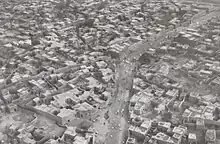
History
An important early center of commerce in the region was Kurmi Market, founded by the Emir of Kano Muhammadu Rumfa in 1463 CE.[18] Subsequent leaders made contributions to the emergence of Kano as a leading commercial centre in Sudanic Africa.[30] During the time of the Kano Emirate, Emir Ibrahim Dabo made a number of administrative reforms, seeking to increase commerce in the region.[31]
Leaders during this time encouraged traders to move from Katsina, capitalising on raids from the Hausa Sultanate of Maradi. The Jihad leaders of the Caliphate encouraged the Kola nut trade, and Kano was the greatest beneficiary with an annual turnover of about $30 million. Craft industries also evolved in the pre-colonial period contributing to the prosperity of the province.
After a British occupation of the region, culminating in the Battle of Kano in February 1903, the region became a part of the Northern Nigeria Protectorate.[32] Kano later became a part of the Northern Region of Nigeria.[6] Kano state was created on May 27, 1967.[6] In 1991, part of Kano State was separated to form Jigawa State.
Geography
Climate
The climate of Kano state is characterised by variability in rainfall between the 70s and 80s, with drought and near drought conditions. Between the 90s and the year 2015, the moisture conditions have improved considerably but for the fluctuation of the rainfall in the state.[33] However, since 2015 till date, there has been an increase in rainfall in the state, which has helped increase agricultural production in this northern Nigerian state considerably.[34] Based on the report of the Nigerian Meteorological Agency (NIMET), the amount of rainfall varies between years with a mean value of 897.7mm.[35]
In the first quarter of 2022, the Nigerian Meteorological Agency sounded an early warning of floods in some states, including Kano state. The agency asserted that their warning was based on the amount and distribution of rainfall that had been observed in the nation during the rainy season. According to the Kano State Emergency Management Agency (SEMA), 25 local government districts experienced flooding as a result of the extreme rain's aftermath.[36]
Temperature
The temperature of Kano has been on the rise since the 60s and this is highly remarkable[37] The annual temperature of the state is between 260C to 300C of dumal temperature, which is high, and measurable between the range of 13.1%, with the relative humidity of between 17% and 90% respectively.[38][39]
Economy
Many large markets exist within Kano today, such as Kurmi Market, Kantin Kwari Market,[40] Sabon Gari Market, Dawanau Market [41] Kofar Wanbai Market, Galadima Market, Kurumi Market, Yankura Market and Bata Market.[18] Many of these markets specialize in a certain product, such as textiles or grain.[18]
Agriculture
Subsistence and commercial agriculture is mostly practised in the outlying districts of the state. Some of the food crops cultivated are millet, cowpeas, sorghum, maize and rice for local consumption while groundnuts and cotton are produced for export and industrial purposes. During the colonial period and several years after the country's independence, the groundnuts produced in the state constituted one of the major sources revenue of the country. Kano State is a major producer of hides and skins, sesame, soybean, cotton, garlic, gum arabic and chili pepper.[42]
A 2018 study of Tudun Wada found that both temperature and rainfall were likely to increase with climate change, causing increased stress on crops, and would require increased climate change adaptation for agricultural practices.[43]
Industry
Kano State is the second-largest industrial Centre after Lagos State in Nigeria and the largest in Northern Nigeria with textile, tanning, footwear, cosmetics, plastics, enamelware, pharmaceuticals, ceramics, furniture and other industries.[17] Others include agricultural implements, soft drinks, food and beverages, dairy products, vegetable oil, animal feeds etc.[44] Kano is also the center of a growing Islamic banking industry in Nigeria.[19][45][46][47][48][49]
Tourism
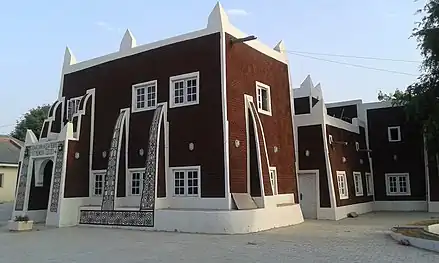
.jpg.webp)

The tourist attractions in the state include:
- Kurmi Market established in the 15th century[50]
- Kano's centuries-old city wall
- Gidan Rumfa (Emir's Palace, the oldest continuous site of authority in Nigeria)[51]
- Kano Zoo[52]
- Dala[53] and Gwauron Dutse[54]
- Gidan Makama (Kano Museum)[53]
- Bashir Tofa Mosque
- Gidan dan Hausa Museum
Natural resources
Kano State has different natural resources[55] in abundant, these include
Mineral raw materials
- Cassiterite
- Copper
- Gemstone
- Glass-sand
- Lead/Zinc
- Pyrochinre & Tantalite
Transport
Federal Highways
- A2 (part of the African Unity Road or Trans-Sahara Highway or Trans Africa 2: TAH2) north from Kaduna State at Gidan Mallam Idi as the Zaria Rd via Kura, Nassarawa, Kano, Bankaura, Kunya, Dambarta and Ajumawa to Jigawa State at Yanzaki,
- A9 (part of the Dakar-Ndjamena Trans-Sahelian Highway or TAH 5) northwest from A2 at Bankaura (14 km north of Kano) via Bichi, Dan Zabuwa and Tsanyawa as IBB Way to Katsina State at Yan Kamaye,
- A237 continuing TAH5 east from A2 in Kano across the Hadejia River at Wudil via Takai and Kachako to Jigawa State as the Kano Rd.
Railways
Kano is on the 1067 mm gauge Western Railway Line from Lagos via Kaduna to Jigawa State (rehabilitated 2013), with a new double track standard gauge line under construction. Rail transport in Nigeria
Airports
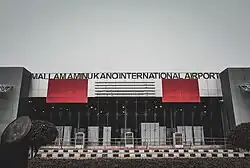
Mallam Aminu Kano International Airport (1936), HQ of Kabo Air, Azman Airlines and Max Air. [56][57]
Education
Secondary Schools
Universities
Kano State is home to five universities: one federal university, one regimented federal university, two states universities, and one private university.
- Bayero University Kano (BUK), founded in 1977.[61]
- Kano State University of Technology (KUST), founded in 2001.[62]
- Skyline University Nigeria (SUN), founded in 2018.[63]
- Yusuf Maitama Sule University, Kano (YUSMUK), founded in 2012.[62]
- Nigeria Police Academy Wudil, founded as the 37th federal university in 2011.[64]
Polytechnics and Colleges
The following is a list of the approved Polytechnics and Colleges in the state of Kano:
Local government areas
Kano State consists of forty-four (44) Local Government Areas (LGAs).
| LGA Name | Area (km2) | Census 2006 population |
Administrative capital | Postal Code |
|---|---|---|---|---|
| Fagge | 21 | 200,095 | Waje | 700 |
| Dala | 19 | 418,759 | Gwanmaja | 700 |
| Gwale | 18 | 357,827 | Gwale | 700 |
| Kano Municipal | 17 | 371,243 | Kofar Kudu | 700 |
| Tarauni | 28 | 221,844 | Unguwa Uku | 700 |
| Nassarawa | 34 | 596,411 | Bompai | 700 |
| Kumbotso | 158 | 294,391 | Kumbotso | 700 |
| Ungogo | 204 | 365,737 | Ungogo | 700 |
| Kano Metropolitan Area | 499 | 2,828,861 | 700 | |
| Dawakin Tofa | 479 | 246,197 | Dawakin Tofa | 701 |
| Tofa | 202 | 98,603 | Tofa | 701 |
| Rimin Gado | 225 | 103,371 | Rimin Gado | 701 |
| Bagwai | 405 | 161,533 | Bagwai | 701 |
| Gezawa | 340 | 282,328 | Gezawa | 702 |
| Gabasawa | 605 | 211,204 | Zakirai | 702 |
| Minjibir | 416 | 219,611 | Minjibir | 702 |
| Dambatta | 732 | 210,474 | Dambatta | 702 |
| Makoda | 441 | 220,094 | Makoda | 702 |
| Kunchi | 671 | 110,170 | Kunchi | 703 |
| Bichi | 612 | 278,309 | Bichi | 703 |
| Tsanyawa | 492 | 157,730 | Tsanyawa | 703 |
| Shanono | 697 | 139,128 | Shanono | 704 |
| Gwarzo | 393 | 183,624 | Gwarzo | 704 |
| Karaye | 479 | 144,045 | Karaye | 704 |
| Rogo | 802 | 227,607 | Rogo | 704 |
| Kabo | 341 | 153,158 | Kabo | 704 |
| Northern Kano State | 8,332 | 3,143,899 | 701 to 704 | |
| Bunkure | 487 | 174,467 | Bunkure | 710 |
| Kibiya | 404 | 138,618 | Kibiya | 710 |
| Rano | 520 | 148,276 | Rano | 710 |
| Tudun Wada | 1,204 | 228,658 | Tudun Wada | 710 |
| Doguwa | 1,473 | 150,645 | Riruwai | 710 |
| Madobi | 273 | 137,685 | Madobi | 711 |
| Kura | 206 | 143,094 | Kura | 711 |
| Garun Mallam | 214 | 118,622 | Garun Mallam | 711 |
| Bebeji | 717 | 191,916 | Bebeji | 711 |
| Kiru | 927 | 267,168 | Kiru | 711 |
| Sumaila | 1,250 | 250,379 | Sumaila | 712 |
| Garko | 450 | 161,966 | Garko | 712 |
| Takai | 598 | 202,639 | Takai | 712 |
| Albasu | 398 | 187,639 | Albasu | 712 |
| Gaya | 613 | 207,419 | Gaya | 713 |
| Ajingi | 714 | 172,610 | Ajingi | 713 |
| Wudil | 362 | 188,639 | Wudil | 713 |
| Warawa | 360 | 131,858 | Warawa | 713 |
| Dawakin Kudu | 384 | 225,497 | Dawakin Kudu | 713 |
| Southern Kano State | 11,554 | 3,410,922 | 710 to 713 |
Demographics
Population
According to the 2006 PON census figures from Nigeria Kano State had a population totaling 9,401,288. Based on the official data by the National Bureau of Statistics.[65], Kano State is the most populous state in the country followed by Lagos State.[66] The state is mostly populated by the Hausa and Fulani people.[20]
| Year | Pop. | ±% |
|---|---|---|
| 1991 | 5,810,470 | — |
| 2006 | 9,401,288 | +61.8% |
| 2016 | 13,076,900 | +39.1% |
| source:[67] | ||
Languages
The official language of Kano State are Hausa and Fulfulde.[68][69]
The Kainji languages Moro, Kurama and Map are also spoken in Doguwa LGA.
Notable people
- Sani Abacha (1943-1998), 10th Military Head of State of Nigeria
- Ja'afar Mahmud Adam (1960-2007), popular Islamic scholar
- Aliko Dangote (born 1957), Nigerian business magnate and philanthropist[70]
- Aminu Dantata (born 1931), Nigerian business magnate and philanthropist
- Rabiu Kwankwaso (born 1956), former Governor of Kano state and former minister of defence of Nigeria,
- Sani Umar Rijiyar Lemo,[71] Islamic preacher
- Murtala Muhammed from 1975 to 1976, 4th Military head of state of Nigeria
- Abdul Samad Rabiu (was born 4 August 1960), Nigerian business magnate and philanthropist[72]
- Sanusi Lamido Sanusi (born 1961), former CBN Governor,[73] former Emir of Kano
- Ibrahim Shekarau (born 1955), former Governor and former Minister of Education (2003-2011).
- Yusuf Babangida Suleiman (born 1976), politician in the 7th, 8th and 9th Kano State House of Assembly
Politics
The state government is led by a democratically elected governor who works closely with the sate house of assembly. The capital city of the state is Kano.[74]
Electoral system
The governor of each state is selected using a modified two-round system. To be elected in the first round, a candidate must receive the plurality of the vote and over 25% of the vote in at least two -third of the State local government Areas. If no candidate passes threshold, a second round will be held between the top candidate and the next candidate to have received a plurality of votes in the highest number of local government Areas.[74]
See also
References
- See List of governors of Kano State for a list of prior governors
- "Demographic Statistics Bulletin 2017". Archived from the original on 22 August 2021.
- "Kano:https://kano state government population". Kanostate population. 30 December 2017. Archived from the original on 20 May 2021. Retrieved 19 May 2021.
- Okeowo, Gabriel; Fatoba, Iyanuoluwa, eds. (13 October 2022). "State of States 2022 Edition" (PDF). Budgit.org. BudgIT. Retrieved 7 March 2023.
{{cite web}}: CS1 maint: date and year (link) - "Sub-national HDI – Area Database – Global Data Lab". hdi.globaldatalab.org. Archived from the original on 23 September 2018. Retrieved 13 September 2018.
- "About Kano". Kano State. 30 December 2017. Archived from the original on 19 May 2020. Retrieved 19 May 2020.
- "2006 Census" (PDF). 19 May 2011. Archived (PDF) from the original on 19 May 2011. Retrieved 14 March 2021.
- "Nigeria Statistics". Archived from the original on 22 August 2021. Retrieved 14 March 2021.
- "Kano/Katsina: Ganduje, Masari, Gaidam sworn-in – P.M. News". Archived from the original on 4 February 2022. Retrieved 4 February 2022.
- "Kano State Government". 1 May 2010. Archived from the original on 1 May 2010. Retrieved 14 March 2021.
- "Hausa" (PDF). Archived (PDF) from the original on 22 February 2022. Retrieved 14 March 2021.
- "Kurmi: Kano's 600-year-old slave market now sanctuary for artifacts - Daily Trust". dailytrust.com. Retrieved 23 October 2023.
- Ujorha, Tadaferua (9 May 2003). "Kano's 500-year-old market". Daily Trust. Biafra Nigeria World. Archived from the original on 7 August 2021. Retrieved 1 November 2007.
- "Embassy of the Federal Republic of Nigeria – History". www.nigeriaembassyusa.org. Archived from the original on 2 March 2021. Retrieved 14 March 2021.
- "The Fall of Kano | History Today". Archived from the original on 7 October 2021. Retrieved 14 March 2021.
- Paden. Religion and Political Culture in Kano. ISBN 0-520-01738-2.
- "Kano Metropolis". Archived from the original on 22 February 2022. Retrieved 27 August 2023..
- "Kano Markets". Kano State. 6 June 2018. Archived from the original on 19 May 2020. Retrieved 19 May 2020.
- "Islamic Finance Nigeria". SukFin. Archived from the original on 30 September 2020. Retrieved 7 May 2020.
- "Nigeria Ethnic Groups|Map". onlinenigeria.com. Archived from the original on 26 January 2021. Retrieved 17 September 2020.
- "Hausa Language Variation and Dialects". African Languages at UCLA. Archived from the original on 4 December 2020. Retrieved 14 March 2021.
- Adoti, Olive (30 July 2020). "10 Top languages spoken in Nigeria (plus the states)". Legit.ng – Nigeria news. Archived from the original on 23 April 2021. Retrieved 14 March 2021.
- Nossiter, Adam (19 March 2013). "Bombs Strike Bus Station in Nigeria (Published 2013)". The New York Times. ISSN 0362-4331. Archived from the original on 18 March 2021. Retrieved 14 March 2021.
- "Nigeria suicide bombers target Potiskum and Kano buses". BBC News. 24 February 2015. Archived from the original on 29 August 2021. Retrieved 29 August 2021.
- "BBC News – Nigeria unrest: Kano mosque attack kills dozens". BBC News. 28 November 2014. Archived from the original on 29 November 2014. Retrieved 29 November 2014.
- Obasanjo Assesses Riot Damage in Kano – 2001-10-16 Archived 7 February 2015 at the Wayback Machine. Voice of America News.
- "Kano: Nigeria's ancient city-state". BBC online. BBC. 20 May 2004. Archived from the original on 18 May 2014. Retrieved 12 July 2007.
- "Geographies of poverty in Kano State: The role of GIS in identifying and mapping multidimensionally deprived households". ResearchGate. Archived from the original on 22 February 2022. Retrieved 14 March 2021.
- "Nigerian singer sentenced to death for blasphemy in Kano state". BBC News. 10 August 2020. Archived from the original on 9 May 2021. Retrieved 14 March 2021.
- "Kurmi Market Kano State :: Nigeria Information & Guide". www.nigeriagalleria.com. Retrieved 23 October 2023.
- Miers, Suzanne; Klein, Martin A. (1999). Slavery and Colonial Rule in Africa. Psychology Press. ISBN 978-0-7146-4884-2. Archived from the original on 4 August 2020. Retrieved 19 May 2020.
- "CAPTURE OF KANO". West Gippsland Gazette (Warragul, Vic. : 1898 – 1930). 19 May 1903. p. 6. Archived from the original on 13 December 2019. Retrieved 19 May 2020.
- Buba, L. F. (2010). Spatio-temporal rainfall and temperature variation in northern Nigeria. A Ph.D. Thesis submitted to the Geography Department , Bayero University, Kano.
- Badamasi, M.M. (2014). Vegetation and Forestry in Tank, A.I. & Morale, S.B. (Eds.) Kano Government, Society and Development. London & Abuja: Adonis and Abbey Publishers.
- "Kano my state". www.kanodashboard.ng. Retrieved 4 October 2023.
- Maishanu, Abubakar Ahmadu (8 November 2022). "SPECIAL REPORT: Traders count losses as floods submerge West Africa's largest textile market in Kano". Premium Times Nigeria. Retrieved 10 November 2022.
- Badamosi, M.M. (2014). Vegetation and Forestry in Tank A.I., Momale, S.B. (eds.) Kano Government, Society and Development. London & Abuja: Adonis and Abbey Publishers.
- Kowal & Knabe, J.M. & D.T. (1972). An agroclimatological atlas of northern states of Nigeria with explanatory notes. Zaria: ABU Press.
- Olofin, E.A. (1987). Some aspects of the physical geographies of the Kano region and related human responses: Departmental lecture notes. Kano, Nigeria: Denis Standaerd Printers.
- "Kantin Kwari market Archives". The Guardian Nigeria News - Nigeria and World News. Retrieved 30 December 2022.
- "Dawanau:46-Yr-Old Kano Market That Determines Cost Of Grains In Nigeria". The Guardian Nigeria News - Nigeria and World News. Retrieved 12 September 2023.
- BusinessDay (24 August 2017). "Ease of Doing Business: Kano State Govt. woos investors with land". Businessday NG. Retrieved 21 October 2023.
{{cite web}}:|last=has generic name (help) - Garba, J.I. (2018). "AWARENESS AND ADAPTATION STRATEGIES TO CLIMATE CHANGE IN TUDUN WADA LOCAL GOVERNMENT AREA OF KANO STATE". Zaria Geographer. 25 (1): 63–75. ISSN 2782-7739.
- "Archived copy" (PDF). Archived (PDF) from the original on 9 September 2021. Retrieved 21 February 2021.
{{cite web}}: CS1 maint: archived copy as title (link) - "Nigeria: cities with the largest population 2020". Statista. Archived from the original on 21 February 2021. Retrieved 21 February 2021.
- Kasim Madugu, Yusuf. "COLLAPSE OF TEXTILE INDUSTRY IN NIGERIA: A STUDY OF KANO STATE, NIGERIA" (PDF). Archived from the original (PDF) on 24 September 2021. Retrieved 27 August 2023.
- "Nigeria biannual economic update: connecting to compete" (PDF). World Bank. Archived (PDF) from the original on 4 May 2021. Retrieved 22 February 2022.
- "Kano". BBC News. Archived from the original on 9 May 2021. Retrieved 21 February 2021.
- "Why is business suffering in Kano?". BBC News. Archived from the original on 22 February 2022. Retrieved 21 February 2021.
- "Kurmi market - Daily Trust - Latest News in Nigeria and the World". Daily Trust. Retrieved 30 December 2022.
- "Google Travel". www.google.com.ng. Retrieved 30 December 2022.
- "Kano Zoo: Shortage of animals, unkept environment bother visitors". Daily Trust. 27 November 2020. Retrieved 30 December 2022.
- Webmaster (23 December 2012). "Gidan Makama: The Story of Kano's Famous Museum". Daily Trust. Retrieved 30 December 2022.
- "Goron Dutse Hill | hill, Nigeria | Britannica". www.britannica.com. Retrieved 30 December 2022.
- "Natural Resources – Welcome To The Embassy of Nigeria". Archived from the original on 26 January 2022. Retrieved 4 February 2022.
- "Malam Aminu Kano International Airport (MAKIA) - Daily Trust". dailytrust.com. Retrieved 23 October 2023.
- "Mallam Aminu Kano International Airport News | Latest news about Mallam Aminu Kano International Airport today, 23 October 2023". Naija News. Retrieved 23 October 2023.
- "Kano State second largest industrial – Google Search". www.google.com. Retrieved 21 February 2021.
- "HISTORY OF DAWAKIN TOFA SCIENCE COLLEGE KANO STATE". datsosa2000.weebly.com. Archived from the original on 22 February 2022. Retrieved 14 September 2021.
- "Science and Technical Schools Board". www.stsbkano.ng. Archived from the original on 14 June 2021. Retrieved 19 May 2021.
- "History, Facts & Figures | Bayero University, Kano". buk.edu.ng. Archived from the original on 19 May 2020. Retrieved 19 May 2020.
- "BRIEF HISTORY OF KUST WUDIL – Kano University of Science and Technology, Wudil". Archived from the original on 5 July 2020. Retrieved 19 May 2020.
- "ABOUT SKYLINE UNIVERSITY NIGERIA". sun.edu.ng. Archived from the original on 11 June 2020. Retrieved 19 May 2020.
- "Nigeria Police Force". www.npf.gov.ng. Archived from the original on 4 March 2021. Retrieved 28 March 2021.
- Demographic Statistics Bulletin 2020
- "Rejections greet census result". Archived from the original on 29 January 2007. Retrieved 28 August 2023.
- "Nigeria: States & Agglomerations – Population Statistics, Maps, Charts, Weather and Web Information". www.citypopulation.de. Archived from the original on 8 July 2019. Retrieved 2 July 2019.
- Ibrahim Ado-Kurawa (2003). "Brief History of Kano 999 to 2003". kanostate.net. Kano State Government Nigeria. Archived from the original on 10 December 2009. Retrieved 7 December 2009.
- "Which languages do locals speak in the Kano state of Nigeria?". Quora. Retrieved 30 December 2022.
- "Aliko Dangote". Forbes. Retrieved 30 December 2022.
- "Ku San Malamanku tare da Dr Sani Umar Rijiyar Lemo". BBC News Hausa (in Hausa). 20 November 2020. Retrieved 27 December 2022.
- "Abdul Samad Rabiu". Forbes. Retrieved 28 May 2023.
- Quadri, Opeyemi (9 May 2022). "List Of CBN Governors From 1958 Till Date". infomediang.com. Retrieved 30 December 2022.
- Oguntola, Tunde (27 September 2022). "2023: Next President, Govs Must Get Two-thirds Spread, Says INEC". Retrieved 23 February 2023.
Further reading
- "Commercial Agriculture Development Project (CADP)". 2010. Archived from the original on 21 September 2014. Retrieved 3 March 2013.
External links
 Media related to Kano State at Wikimedia Commons
Media related to Kano State at Wikimedia Commons- National Bureau of Statistics Maps of Kano State

